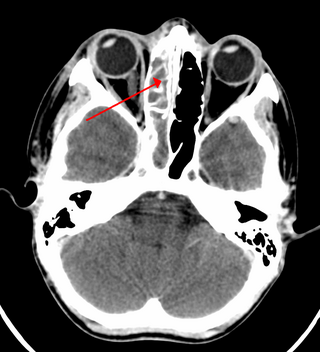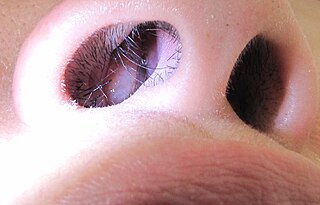Related Research Articles

Sinusitis, also known as rhinosinusitis, is inflammation of the mucous membranes that line the sinuses resulting in symptoms that may include thick nasal mucus, a plugged nose, and facial pain. Other signs and symptoms may include fever, headaches, a poor sense of smell, sore throat, a feeling that phlegm is oozing out from the back of the nose to the throat along with a necessity to clear the throat frequently and frequent attacks of cough.

Nasal polyps (NP) are noncancerous growths within the nose or sinuses. Symptoms include trouble breathing through the nose, loss of smell, decreased taste, post nasal drip, and a runny nose. The growths are sac-like, movable, and nontender, though face pain may occasionally occur. They typically occur in both nostrils in those who are affected. Complications may include sinusitis and broadening of the nose.

Aspirin-exacerbated respiratory disease (AERD), also called NSAID-exacerbated respiratory disease (NERD/N-ERD) or historically aspirin-induced asthma and Samter's Triad, refers to the triad of asthma, chronic rhinosinusitis with nasal polyps, and intolerance of aspirin and other nonsteroidal anti-inflammatory drugs (NSAIDs). AERD most commonly begins in early- to mid-adulthood and is a chronic disease that has no known cure. The cause of the disease is a dysregulation of the arachidonic acid metabolic pathway and of various innate immune cells, though the initial cause of this dysregulation is not currently known. While NSAID intolerance is a defining feature of AERD, simple avoidance does not prevent the onset, development or perennial nature of the disease.

Nasal irrigation is a personal hygiene practice in which the nasal cavity is washed to flush out mucus and debris from the nose and sinuses, in order to enhance nasal breathing. Nasal irrigation can also refer to the use of saline nasal spray or nebulizers to moisten the mucous membranes.

The pyramid-shaped maxillary sinus is the largest of the paranasal sinuses, located in the maxilla. It drains into the middle meatus of the nose through the semilunar hiatus. It is located to the side of the nasal cavity, and below the orbit.
Balloon sinuplasty is a procedure that ear, nose and throat surgeons may use for the treatment of blocked sinuses. Patients diagnosed with sinusitis but not responding to medications may be candidates for sinus surgery. Balloon technology was initially cleared by the U.S. Food and Drug Administration in 2005 and is an endoscopic, catheter-based system for chronic sinusitis. It uses a balloon over a wire catheter to dilate sinus passageways. The balloon is inflated with the goal of dilating the sinus openings, widening the walls of the sinus passageway and restoring normal drainage.
Silent sinus syndrome is a spontaneous, asymptomatic collapse of an air sinus associated with negative sinus pressures. It can cause painless facial asymmetry, diplopia and enophthalmos. Diagnosis is suspected based on symptoms, and can be confirmed using a CT scan. Treatment is surgical involving making an outlet for mucous drainage from the obstructed sinus, and, in some cases, paired with reconstruction of the orbital floor. It is slightly more common in middle age.

Maxillary sinus floor augmentation is a surgical procedure which aims to increase the amount of bone in the posterior maxilla, in the area of the premolar and molar teeth, by lifting the lower Schneiderian membrane and placing a bone graft.
Chronic atrophic rhinitis, or simply atrophic rhinitis, is a chronic inflammation of the nose characterised by atrophy of nasal mucosa, including the glands, turbinate bones and the nerve elements supplying the nose. Chronic atrophic rhinitis may be primary and secondary. Special forms of chronic atrophic rhinitis are rhinitis sicca anterior and ozaena. It can also be described as the empty nose syndrome.

Functional endoscopic sinus surgery (FESS) is a procedure that is used to treat sinusitis and other conditions that affect the sinuses. Sinusitis is an inflammation of the sinuses that can cause symptoms such as congestion, headaches, and difficulty breathing through the nose.

An odontogenic infection is an infection that originates within a tooth or in the closely surrounding tissues. The term is derived from odonto- and -genic. The most common causes for odontogenic infection to be established are dental caries, deep fillings, failed root canal treatments, periodontal disease, and pericoronitis. Odontogenic infection starts as localised infection and may remain localised to the region where it started, or spread into adjacent or distant areas.
ELOM-080 is the active ingredient of the herbal medicine named GeloMyrtol forte. The acronym ELOM stands for the oils from Eucalyptus, Lemon, (Sweet) Orange and Myrtle that it contains.
Intersect ENT, a subsidiary of Medtronic, is a health care equipment company based in Menlo Park, California. It manufactures drug-delivery devices used by Ear, Nose & Throat (ENT) clinicians in the treatment of sinusitis. Intersect ENT is best known for developing the first bioabsorbable drug-eluting sinus stent PROPEL, which delivers anti-inflammatory medication directly to the sinuses. The company holds over 20 issued patents in the United States and more than 80 patents and patent applications worldwide. The company was named on the Forbes list of America's Most Promising Companies and was also on the Fierce 15 list of Most Promising Companies in 2013.

A Sinus implant is a medical device that is inserted into the sinus cavity. Implants can be in conjunction with sinus surgery to treat chronic sinusitis and also in sinus augmentation to increase bone structure for placement of dental implants.
Antral lavage is a largely obsolete surgical procedure in which a cannula is inserted into the maxillary sinus via the inferior meatus to allow irrigation and drainage of the sinus. It is also called proof puncture, as the presence of an infection can be proven during the procedure. Upon presence of infection, it can be considered as therapeutic puncture. Often, multiple repeated lavages are subsequently required to allow for full washout of infection.
Caldwell-Luc surgery, Caldwell-Luc operation, also known as Caldwell-Luc antrostomy, and Radical antrostomy, is an operation to remove irreversibly damaged mucosa of the maxillary sinus. It is done when maxillary sinusitis is not cured by medication or other non-invasive technique. The approach is mainly from the anterior wall of the maxilla bone. It was introduced by George Caldwell (1893)and Henry Luc (1897). The maxillary sinus is entered from two separate openings, one in the canine fossa to gain access to the antrum and other in the naso antral wall for drainage.

Fungal sinusitis or fungal rhinosinusitis is the inflammation of the lining mucosa of the paranasal sinuses due to a fungal infection. It occurs in people with reduced immunity. The maxillary sinus is the most commonly involved. Fungi responsible for fungal sinusitis are Aspergillus fumigatus (90%), Aspergillus flavus, and Aspergillus niger. Fungal sinusitis occurs most commonly in middle-aged populations. Diabetes mellitus is the most common risk factor involved.

Oroantral fistula (OAF) is an epithelialised oroantral communication (OAC). OAC refers to an abnormal connection between the oral cavity and antrum. The creation of an OAC is most commonly due to the extraction of a maxillary (upper) tooth closely related to the antral floor. A small OAC may heal spontaneously but a larger OAC would require surgical closure to prevent the development of persistent OAF and chronic sinusitis.
Exhalation delivery systems (EDS) deliver medications to the internal nose. Developed in 2006, EDS devices use the patient's exhaled breath to propel medication, such as steroids, into the nasal cavities. The method can deliver medication deeper into the nasal passages than intranasal sprays, and at a lower pressure than nasal irrigation methods.
Nasal surgery is a medical procedure designed to treat various conditions that cause nasal blockages in the upper respiratory tract, for example nasal polyps, inferior turbinate hypertrophy, and chronic rhinosinusitis. It encompasses several types of techniques, including rhinoplasty, septoplasty, sinus surgery, and turbinoplasty, each with its respective postoperative treatments. Furthermore, nasal surgery is also conducted for cosmetic purposes. While there are potential risks and complications associated, the advancement of medical instruments and enhanced surgical skills have helped mitigate them.
References
- 1 2 3 Craig, John R.; Poetker, David M.; Aksoy, Umut; Allevi, Fabiana; Biglioli, Federico; Cha, Bruce Y.; Chiapasco, Matteo; Lechien, Jerome R.; Safadi, Ahmad; Simuntis, Regimantas; Tataryn, Roderick; Testori, Tiziano; Troeltzsch, Matthias; Vaitkus, Saulius; Yokoi, Hidenori. "Diagnosing odontogenic sinusitis: An international multidisciplinary consensus statement". International Forum of Allergy & Rhinology. 11 (8): 1235–1248. doi:10.1002/alr.22777. hdl: 2027.42/168522 . ISSN 2042-6976.
- ↑ Craig, John R. "Odontogenic sinusitis: A state‐of‐the‐art review". World Journal of Otorhinolaryngology - Head and Neck Surgery. 8 (1): 8–15. doi:10.1002/wjo2.9. ISSN 2095-8811. PMC 9126162 . PMID 35619928.
- ↑ Grayson, Jessica W.; Hopkins, Claire; Mori, Eri; Senior, Brent; Harvey, Richard J. (2020-09-01). "Contemporary Classification of Chronic Rhinosinusitis Beyond Polyps vs No Polyps: A Review". JAMA Otolaryngology–Head & Neck Surgery. 146 (9): 831. doi:10.1001/jamaoto.2020.1453. ISSN 2168-6181.
- ↑ Craig, John R.; Dai, Xiangguo; Bellemore, Stacey; Woodcroft, Kimberley J.; Wilson, Carl; Keller, Christian; Bobbitt, Kevin R.; Ramesh, Mayur. "Inflammatory endotype of odontogenic sinusitis". International Forum of Allergy & Rhinology. 13 (6): 998–1006. doi:10.1002/alr.23099. ISSN 2042-6976.
- ↑ Felisati, Giovanni; Chiapasco, Matteo; Lozza, Paolo; Saibene, Alberto Maria; Pipolo, Carlotta; Zaniboni, Marco; Biglioli, Federico; Borloni, Roberto. "Sinonasal Complications Resulting from Dental Treatment: Outcome-Oriented Proposal of Classification and Surgical Protocol". American Journal of Rhinology & Allergy. 27 (4): e101–e106. doi:10.2500/ajra.2013.27.3936. ISSN 1945-8924.
- ↑ Molteni, Marco; Bulfamante, Antonio Mario; Pipolo, Carlotta; Lozza, Paolo; Allevi, Fabiana; Pisani, Antonia; Chiapasco, Matteo; Portaleone, Sara Maria; Scotti, Alberto; Maccari, Alberto; Borloni, Roberto; Felisati, Giovanni; Saibene, Alberto Maria. "Odontogenic sinusitis and sinonasal complications of dental treatments: a retrospective case series of 480 patients with critical assessment of the current classification". Acta Otorhinolaryngologica Italica. 40 (4): 282–289. doi:10.14639/0392-100X-N0457. ISSN 1827-675X. PMC 7586196 . PMID 33100340.
- ↑ Saibene, Alberto Maria; Vassena, Christian; Pipolo, Carlotta; Trimboli, Mariele; De Vecchi, Elena; Felisati, Giovanni; Drago, Lorenzo. "Odontogenic and rhinogenic chronic sinusitis: a modern microbiological comparison: Odonto- and rhinogenic sinusitis microbiology". International Forum of Allergy & Rhinology. 6 (1): 41–45. doi:10.1002/alr.21629.
- ↑ Yassin‐Kassab, Abdulkader; Bhargava, Pallavi; Tibbetts, Robert J.; Griggs, Zachary H.; Peterson, Edward I.; Craig, John R. "Comparison of bacterial maxillary sinus cultures between odontogenic sinusitis and chronic rhinosinusitis". International Forum of Allergy & Rhinology. 11 (1): 40–47. doi: 10.1002/alr.22627 . ISSN 2042-6976.
- ↑ Goyal, Vinay K.; Ahmad, Abid; Turfe, Zaahir; Peterson, Edward I.; Craig, John R. "Predicting Odontogenic Sinusitis in Unilateral Sinus Disease: A Prospective, Multivariate Analysis". American Journal of Rhinology & Allergy. 35 (2): 164–171. doi:10.1177/1945892420941702. ISSN 1945-8924.
- ↑ Saibene, Alberto Maria; Pipolo, Giorgia Carlotta; Lozza, Paolo; Maccari, Alberto; Portaleone, Sara Maria; Scotti, Alberto; Borloni, Roberto; Messina, Francesco; Di Pasquale, Daniele; Felisati, Giovanni. "Redefining boundaries in odontogenic sinusitis: a retrospective evaluation of extramaxillary involvement in 315 patients: Odontogenic sinusitis extramaxillary involvement". International Forum of Allergy & Rhinology. 4 (12): 1020–1023. doi:10.1002/alr.21400.
- ↑ Allevi, Fabiana; Fadda, Gian Luca; Rosso, Cecilia; Martino, Federica; Pipolo, Carlotta; Cavallo, Giovanni; Felisati, Giovanni; Saibene, Alberto Maria. "Diagnostic Criteria for Odontogenic Sinusitis: A Systematic Review". American Journal of Rhinology & Allergy. 35 (5): 713–721. doi:10.1177/1945892420976766. ISSN 1945-8924.
- ↑ Craig, John R.; Tataryn, Roderick W.; Aghaloo, Tara L.; Pokorny, Alan T.; Gray, Stacey T.; Mattos, Jose L.; Poetker, David M. "Management of odontogenic sinusitis: multidisciplinary consensus statement". International Forum of Allergy & Rhinology. 10 (7): 901–912. doi:10.1002/alr.22598. ISSN 2042-6976.
- ↑ Craig, John R.; Cheema, Atif J.; Dunn, Raven T.; Vemuri, Swapna; Peterson, Edward L. "Extrasinus Complications From Odontogenic Sinusitis: A Systematic Review". Otolaryngology–Head and Neck Surgery. 166 (4): 623–632. doi:10.1177/01945998211026268. ISSN 0194-5998.
- ↑ Yassin-Kassab, Abdulkader; Peterson, Edward L.; Craig, John R. "Total times to treatment completion and clinical outcomes in odontogenic sinusitis". American Journal of Otolaryngology. 44 (4): 103921. doi:10.1016/j.amjoto.2023.103921.
- ↑ Mehra, Pushkar; Murad, Haitham. "Maxillary sinus disease of odontogenic origin". Otolaryngologic Clinics of North America. 37 (2): 347–364. doi:10.1016/S0030-6665(03)00171-3.
- ↑ Bulfamante, Antonio Mario; Ferella, Francesco; Miller, Austin Michael; Rosso, Cecilia; Pipolo, Carlotta; Fuccillo, Emanuela; Felisati, Giovanni; Saibene, Alberto Maria. "Artificial intelligence, machine learning, and deep learning in rhinology: a systematic review". European Archives of Oto-Rhino-Laryngology. 280 (2): 529–542. doi:10.1007/s00405-022-07701-3. ISSN 0937-4477. PMC 9849161 . PMID 36260141.